Short Run Cost in Economics Class 11
Short run cost class 11 notes are presented in this post for easy access to the students. Short-run cost is such a cost that is incurred during the short run of a production process. We know that in the short run, some factors are fixed, while others are variable. Similarly, short-run costs are also divided into two kinds of costs – Fixed Costs and Variable Costs. Let us look at the different short-run costs in detail.
Short Run Total Cost (TC) under Short Run Cost in Economics
Short Run Cost in Economics explains the total cost as;
The total of the fixed cost and the variable cost is known as the Total Cost (TC). Total cost is the total expenditure incurred by a firm on the factors of production required for the production of a commodity.
There are two types of total costs, Total Fixed Cost (TFC) and Total Variable Cost (TVC).
TC is the sum of TFC and TVC at various levels of output.
Total Fixed Cost (TFC) refers to those short-run costs which do not directly vary with the level of output. TFC is incurred on fixed factors like machinery, plant, land, building, etc., which cannot be changed in the short run. The payment to these factors remains the same irrespective of the output level. TFC remains the same whether the output is large, small, or even zero. For example, rent of premises, interest on the loan, the salary of permanent staff, and insurance premiums.
Total Variable Costs (TVC) refer to those short-run costs which directly vary with the level of output. TVC is incurred on variable factors like raw material, direct labour, power, etc., which changes with the output level. This means that TVC rises with an increase in output and falls with a decrease in output. TVC is incurred till there is production, and it becomes zero at zero level of production.
The concept of Total Cost can be better understood with a schedule and diagram given below,
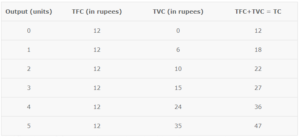
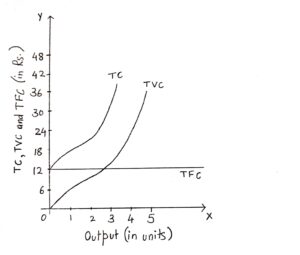
We can observe the following things from the graph given above –
- The TFC curve is a horizontal straight line parallel to the x-axis, as it remains constant at all output levels.
- TC and TVC are inversely S-shaped because they rise initially at a decreasing rate, then at a constant rate, and then at an increasing rate. This is because of the law of variable proportions.
- At zero output, TC equals TFC, as there is no variable cost at zero output level.
- The vertical distance between the TFC curve and the TC curve is equal to TVC.
- TC and TVC are parallel, and the constant vertical distance represents TFC.
Short Run Marginal Cost (MC)
Short Run Cost in Economics explains marginal cost as;
Marginal cost refers to those short-run costs which are an addition to the total cost when one more unit of output is produced.
MCn = TCn – TCn-1
Where,
MCn = Marginal cost of nth unit
TCn = Total cost of n units
TCn-1 = Total cost of (n-1) units
n = number of units produced
We now know that MC is the change in TC when one more unit of output is produced. However, when a change in units produced is more than one unit, then MC can be calculated as,
MC = Change in Total Cost/ Change in units of Output
MC = ΔTC/ΔQ
If the TC of producing two units is Rs. 200 and the TC of producing five units is Rs. 350, then MC will be,
MC = TC of 5 – TC of 2/5 -2
MC = 350-200/5-2 = 150/3
MC = Rs. 50
We know that MC is the change in TC when one more unit of output is produced, and TC = TFC + TVC. TFC is not affected by a change in the level of output. Therefore, MC is independent of TFC and is affected only by TVC. Therefore, MC can also be written as,
MCn = TVCn – TVCn-1
Let us now understand the concept of MC with the help of a schedule and diagram,
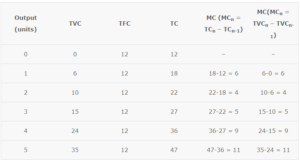
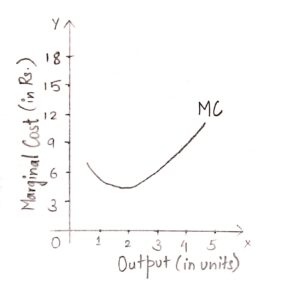
MC can be calculated from both TC and TVC. The MC curve is obtained by plotting the points shown in the table. As we can see from the graph, the MC curve is U-shaped, i.e., MC falls till it reaches its minimum point, and then it starts rising. The reason behind its U-shape is the Law of Variable Proportions.
Short Run Average Cost (AC)
The per-unit short-run costs explain the relationship between cost and output more realistically. From Total Fixed Cost (TFC), Total Variable Cost (TVC), and Total Cost (TC), we can obtain Average Fixed Cost (AFC), Average Variable Cost (AVC), and Average Cost (AC) or Average Total Cost (ATC).
Average Fixed Cost (AFC) refers to the fixed cost of production per unit. It is calculated by dividing the TFC by the total output (Q),
AFC = TFC/Q
AFC falls with an increase in output because TFC remains the same at all output levels in the short run.
Average Variable Cost (AVC) refers to the per unit variable short-run cost of production. It is calculated by dividing TVC by the total output.
AVC = TVC/Q
AVC initially falls with an increase in output. Once the output rises to an optimum level, AVC starts rising.
Average Total Cost or Average Cost (AC) refers to the per unit total cost of production. It is calculated by dividing TC by the total output.
AC = TC/Q
It can also be defined as the sum of AFC and AVC,
AC = AFC + AVC
We can understand all these concepts better with the help of a schedule and a graph.
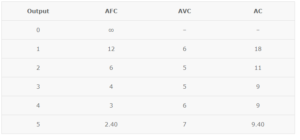
![]()

As we can see from the graph above, the AC curve will always lie above the AVC curve because AC at all output levels includes both AVC and AFC. The AFC curve is a rectangular hyperbola and never touches either axis. As the output increases, the gap between AC and AVC curves decreases, but they never intersect. This happens because the vertical distance between them is AFC which can never be zero.
Short run cost class 11 notes are helpful for students as they are short and crisp. These notes help you to stay active and engaged during your lectures, reading, and revision. They also help you to understand what you are learning and clarify your thinking. Be selective and identify key ideas. These notes are a useful record of key information and the sources of that information. These notes help you remember what you heard.